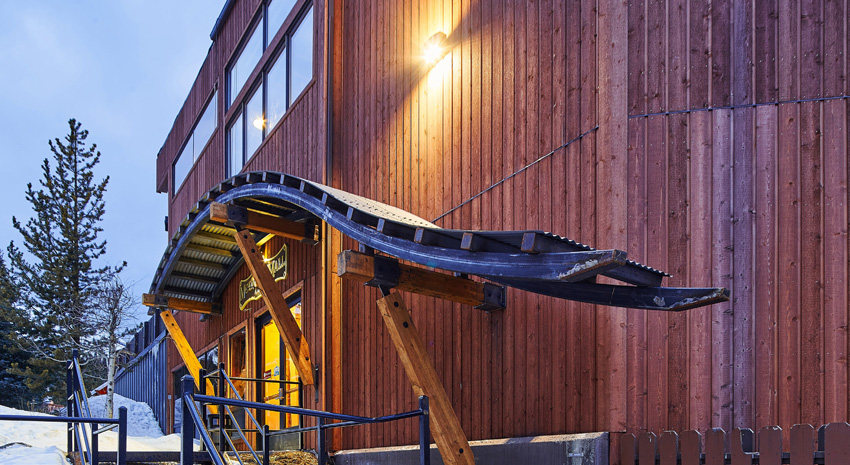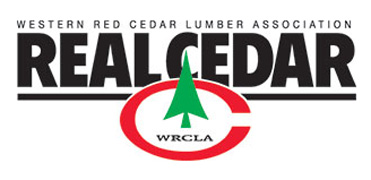Western Red Cedar
Grades of Western Red Cedar Decking
Whether used for a traditional deck or a ceiling application to add warmth to a contemporary design, decking is available in a number of grades.
Architect Clear is considered the ultimate in appearance. Its fine-grained appearance should meet the needs of the most demanding clients. All aspects of manufacturing and quality control are performed to the highest standards of the lumber industry. This is an exclusive product that is usually manufactured to individual order.
Custom Clear is a high-quality product that combines the stability and beauty of Western Red Cedar with a sophisticated clear appearance that will please the most discriminating tastes. Its finely machined surface shows limited characteristics that do not detract from its appearance. It is a natural choice for custom residences and other applications where fine woodwork is desired.
An architectural knotty grade has been described as rustic charm at its best. It is sound and tightly knotted. The smooth, skip-free dressing over the entire face makes it the ideal deck surface. For architects and specifiers, it would be a top choice where the natural beauty and lasting charm of a knotty deck are desired.

Photo courtesy of Ryan Day Thompson
Big Sky Ski Resort Mountain Mall by Centre Sky Architects Ltd.
Finishing Options
To achieve the desired aesthetic and performance results, the designer or specifier should become familiar with finishing options. And Western Red Cedar offers a myriad of appropriate choices. The species is rich in extractives that enhance durability yet free of the pitch and resin found in other softwoods. That makes it well suited for a robust range of finishes, from lightly toned semitransparent solutions to two-coat solid colors. Cedar ranks at the top in its ability to accept and maintain a finish. Here are some options:
Opaque Finishes
Paint offers the greatest surface protection against weathering and wetting by water while providing color and concealing some of the wood’s characteristics. Although paint can reduce wood’s absorption of water, paint itself is not a preservative. Alkyd oil-based primers usually offer the best shield against discoloration by water-soluble extractives. Latex paint, particularly 100 percent acrylic formulations, remain more flexible with age and are better able to accommodate dimensional changes, as they stretch and shrink as the wood expands and contracts.
Solid-color stains are simply opaque finishes with fewer solids than paint. Available in a wide spectrum of hues, solid-color stains obscure the wood’s true color but allow some of the natural characteristics and texture of cedar to remain.
Solid-color stains perform best on textured surfaces. They are nonpenetrating and, like paints, form a film. A stain-blocking primer should be applied first, followed by a 100 percent acrylic latex-based topcoat.
Paint and solid finishes are the longest lasting on Western Red Cedar siding and trim.
Natural Finishes
Water repellents and water-repellent preservatives may be applied to cedar used above ground. These formulations reduce water absorption in the short term. The addition of a fungicide that inhibits the growth of mildew and decay fungi will further increase wood’s durability.
Semitransparent stains may be latex or oil based. The semitransparent nature of the stain, due to its low solids content, does not block all UV rays, and some will reach the wood’s surface. Latex stains do not penetrate the surface and may form a film.
It is important to note that transparent, nonflexible, film-forming finishes such as lacquer, shellac, urethane, and varnish are not recommended for exterior use on cedar. UV rays can penetrate the transparent film and degrade the wood. Regardless of the number of coats, the finish will eventually become brittle, develop severe cracks, and then fail.
A Word about Application of Finishes
How a finish is applied to cedar is as important for durability and good performance as is the finish-substrate combination chosen for the job. Finishes can be brushed, rolled, sprayed, or applied by dipping. The application technique, the quality and quantity of finish applied, the surface condition of the substrate, and the weather conditions at the time of application can substantially influence the life expectancy of the finish. The application guidelines suggested here should be followed in concert with the manufacturer’s directions for the product.
For optimum performance, the Western Red Cedar Lumber Association recommends that Western Red Cedar be preprimed or prefinished on all six sides prior to job site delivery. Factory priming, as the name implies, is performed in an industrial setting where a machine coating process applies a primer to all six sides of each piece. The coated pieces are then dried prior to shipment to the job site. Preprimed siding and trim boards delivered to a job site should be kept dry and clean prior to installation. All field cuts should be resealed with a primer prior to the pieces being installed. Top coating should be completed as quickly as possible, as most primers are not intended to be exposed to natural weathering for more than 90 days.
Factory finishing is similar to the above process, however, it allows for the additional application of one or two topcoats of acrylic latex paint, solid stains, or natural stains in job lot quantities and in the colors selected by the builder/homeowner. It is important not to overdrive nails during installation of factory-finished siding, as this will damage the surrounding wood and coating. Overdriven nails must be remedied immediately by filling the depression with exterior grade wood putty or caulk specifically designed for this purpose. The subcontractor should touch up any repairs or field cuts, taking care not to smear the topcoat. When properly done, factory priming/ finishing provides:
- The application of a uniform coating at the recommended coverage of the primer/stain to all six surfaces of each piece (face, back, edges, and ends)
- A controlled environment to permit proper curing of the finish
- The wood with a coating to protect it from exposure to sunlight (UV degradation) and surface contamination by mildew and dirt
- An elimination of lap marks, streaks, and shrink lines after installation
- The ability to install products at any time of the year
- A product that often comes with a coating warranty
Conclusion
An architect who specifies Western Red Cedar in a contemporary design brings together the soul of native cultures with the clean lines of modern architecture. With products available from sustainably managed forests and LCAs and EPDs that indicate the product’s favorable green characteristics, Western Red Cedar can now help earn LEED points toward a green certification. While the reddish wood harvested from the Pacific Northwest, British Columbia, and Alaska is enjoying current trendiness, it has an unusually long proven history of stability and durability. When the designer specifies Western Red Cedar to bring warmth to the modern styling of a commercial building, a school, a civic building, or a custom home, the melding of history and modernity comes through. By learning about the history and geography of Western Red Cedar, along with its proven qualities and scientifically quantified sustainability, the architect or specifier is in a better position to consider this wood to bring a warm aesthetic to a modern building.
End Notes
1Nyrud, Anders Q.; Bysheim, Kristian; and Bringslimark, Tina. Health Benefits from Wood Interior in a Hospital Room. Proceedings of the International Convention of Society of Wood Science and Technology and United Nations Economic Commission for Europe – Timber Committee. 11–14 October 2010. Web. 17 November 2016. www.swst.org/meetings/AM10/pdfs/WS-56%20Nyrud%20Paper.pdf.
2Stewart, Jon. Cedar: Tree of Life to the Northwest Coast Indians. 1 March 1995. Web. 28 November 2016. www.amazon.com/Cedar-Tree-Northwest-Coast-Indians/dp/0295974486.
3Harrington, Connie. Biology and Management of Western Redcedar. U.S. Forest Service. 21 March 2016. Web. 17 November 2016. extension.oregonstate.edu/clackamas/sites/default/files/harrington19bredcedar1-40ppt.pdf.
4Thuja plicata. Wikipedia. Web. 17 November 2016. en.wikipedia.org/wiki/Thuja_plicata.

|
The Western Red Cedar Lumber Association represents quality “Real Cedar” producers, distributors, and retailers throughout North America. Founded in 1954 and known as “the voice of the cedar industry,” WRCLA offers extensive resources to assist with selection, specification, and quality standards. For more information, visit www.realcedar.com. |








